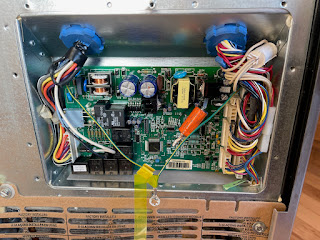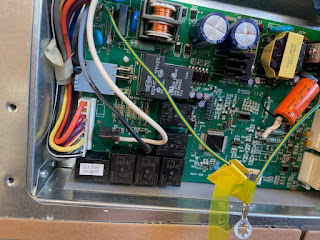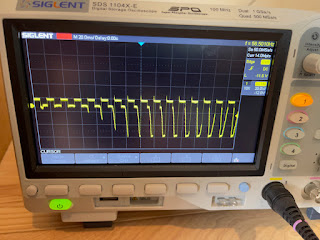the frozen shrimps were all thawed so I shelled and marinated them; none of the shrimps went to waste
Fortunately I have another smaller LG refrigerator in the laundry room, so I transfer all the food to it.
time to dig into what has failed this time around
the first thing to check is the control board that I repaired last time
the coaxial electrolytic capacity I shoehorned in did not fail so it must be something else
I notice there is this solder splash that might had cause a short, but checking closer it is superficial
I could hear a faint sound of motor running, but it is too faint for the sound of a compressor. Next is to see if the compressor runs
most people has no idea GE appliances had long has nothing to do with General Electric; it has long been owned by a Chinese company Haier
I removed the main controller board to clean up the solder splash
I remove the fiberboard cover to access the compressor
the compressor is made by Embraco; by listening closely I determine it was not running; note the 230V-53 to 150Hz label
Until now I never heard of Embraco. A bit of research would tell me it is originally a Brazilian company. It produces world's lion share of refrigeration compressors, especially for domestic appliances. Nearly all the fridge manufacturer that don't produce their own compressors use Embraco's.
The compressor was not running. The faint motor running sound was originated from the condenser cooling fan. The 230Vac on the compressor initially threw me a curve ball. How could a 120V refrigerator has a 230Vac compressor. I then realize it must be an inverter driver compressor. Attached to the compressor is a beige color plastic box. It is very hard to see what it is but with the iPhone I could snap a few photos of the label. It sure looks like an electronic module.
it take a lot of body contortion to remove the electronic module
this is the connector to the dumb compressor with only three contacts
While the plastic housing of the module has signs of overheating, one cannot assume it is abnormal as often with these consumer products the plastic housing is intended to conduct and dissipate heat generated by the electronic devices.
More careful reading of the label one would realize this module convert 115V 60Hz single phase AC into 230V three phase AC with variable frequency between 53 and 150 Hz. So by definition this is an inverter driven variable speed and load compressor.
Next I verified 115Vac power is present at the input of the inverter module. That suggest the problem must lie with the inverter module, or the compressor. I conducted an ohmic check on the three compressor contacts and the resistance read in par with all three with respect to each other. It is a delta three phase topology.
Next is to dig into the inverter board to see if it generates 230V three phase AC for the compressor. To do this one has to be very careful as the chance is the 230V outputs are not floated but reference to the earth ground. As the oscilloscope is also grounded, one can easily blow up the oscilloscope.
The conformal coating on the circuit board made analyzing the signals with the oscilloscope difficult. Also the tight confine making probing the module's three phase compressor electrical drive impossible without making a debugging adapter harness.
this is the input signal sent by the fridge main control board
the signals on all three compressor drive are too low in amplitude
GE Appliances is owned by Haier in China
I tried to find documentations for the inverter module on Embraco's website but there is next to nothing. Additionally they constantly changing the model numbers of basically the same design periodically. I simply cannot find the model number of mine. There are two major signaling by the fridge controller, and how that are done is also obscured.
From my research I pretty soon notice there is a cottage industry of people refurbishing these modules and reselling them on the like of eBay. There are also generic new modules being sold for different makes and models of fridges. I soon infer one common cause of the failure are the 33uF 25V SMD electrolytic capacitors. I first decided to order a batch of these capacitors from eBay. Even if the capacitors are the cause, replacing them will involving cutting the layer of conformal coating to get to the solder pads.
However after ordering the capacitors I decided to risk purchase a new module that has the lowest price even though it does not identify GE as a compatible brand, let along the specific model of fridge. I did it to hedge my odds of getting it repaired with the shortest downtime possible. Neither has any assurance my attempt would be successful.
two types of control signals - frequency and drop-in
It would be over a week before either of these purchases to arrive from the time of order. Patience pays.



















.jpeg)


























No comments:
Post a Comment